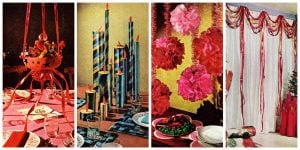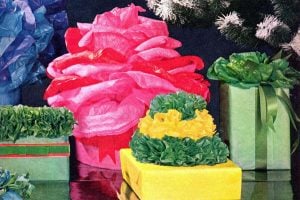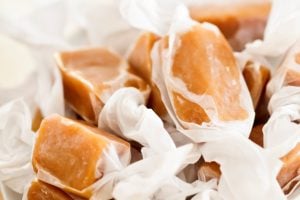If so, here are more than 20 ideas from the 1920s for some vintage pine needle crafts & decor ideas you should love!
Ideas for weaving with pine needles (1920)
By Anne B and Helen B Call – Ladies’ Home Journal (1920)
Projects shown: A decorative basket of pine needles with border done in red, orange and black raffia.
Hairpin basket decorated with pine cones.
Here are two unusual baskets: one is decorated with raffia flowers and the other with a border.
The jewel basket above is lined with satin to protect delicate trinkets.
At the left is a workbag; below, a basket decorated with holly and cones.
This graceful vase is the complement of any single flower. The workbasket beside it is roomy and good to look upon.
The triangular basket and the one below it are unusual in shape as well. The one with handles is trimmed with raffia roses.

Now is the time to do pine-needle work for the summer porch (1921)
The Ladies’ Home Journal – March 1921
The fragrant pine needle lends itself almost irresistibly to basketwork. It is firm yet supple, and its soft brown shades seem to invite decoration in gayly colored raffia.
For the convenience of the weaver, apparently, the needles come in groups of three, with a sheath holding them together at the base.
In lighter baskets, two of these groups are used at a time; in heavier, three or four. They are best sewed by brown raffia in a plain chain stitch. Simply sew the coils together, splitting the stitch on the preceding coil.

If you are fortunate enough to live in the South, you can pick up your pine needles just when they fall from the tree, before they have lost their pliancy and pretty orange color.
If you have to send away for them, wrap them overnight in a damp cloth. Do not let them get too damp, however, if you wish your basket to be strong and firm and the shape true.
The vase basket with three handles
Make a disk four inches in diameter to start the vase basket with the handles shown at the left of the upper illustration, turning so that the right side will be in inside of the basket. Flare out so that when the basket has reached a height of one and a quarter inches it has attained a diameter of seven inches.
Then turn in very slightly and work up to a height of three and a half inches. The diameter of the opening should then be four inches and finished with a stripe.
ALSO SEE: Folk-art painted furniture: Upcycle & renew furniture with tips from famed vintage artist Peter Hunt

The handles are placed equidistant and are three in number. Make a wire triangle with base of one and a half inches and sides of three and a half inches. Pad this with pine needles and wrap with raffia, then work this full of the pine-needle work, working from the outside in.
When it is full, turn over, and, taking the first color you intend to use, make a stitch down the side half way and bring up through the first stitch and down to the points, until you have four long stitches from the base of your triangle to the apex.
Fill in the uncovered parts of the triangle in the same manner with the other colors, until it has the appearance of the photograph. Bend these handles, as indicated, and fasten to the basket with base of triangle at top and apex at the turn.
Flower jar for a pottery spill
Either a pottery spill or a straight tall glass jar may be used to make the flower jar in the center. First, make a ring of wire just the size of the mouth of the spill, pad and wrap with raffia. Now sew on one or two rounds of needles, according to the thickness of the spill, turn straight down, going about one-third the height of the spill, and finish with a stripe.
Make the bottom the same way, starting with a smaller ring. Slip these on the spill and lace together with vertical lines of raffia, trying to use a number of these vertical lines divisible by four.
Use some other color of raffia and knot together in groups of four. Take another color and knot together again in groups of four, using two from each previous group. Continue in this manner until three or five colors have been used.
Making the low flower jar
Take two groups of needles for the low jar above at the right, and wrap for about two inches with the raffia, making it secure; then coil, sewing together. Continue to sew the pine needles to the coil, working either from right to left or left to right, as most natural.
It is perhaps better to work from right to left, if possible. Take each stitch either through the one in the row below or just beside it, so that the stitches spread out in an even chain from the center. Where the distance between stitches becomes too great for firm work place a new stitch, starting another chain.
In this manner, make a disk three inches in diameter, finishing it with a stripe made by wrapping the needles with the raffia between stitches. Sometimes a wire is bound into these stripes to furnish extra strength.
Hold the disk thus made so that the right side will be the inside of the basket and turn up, flaring slightly, to the height of three inches. Now add a stripe and turn in, working plain for half an inch, and add another stripe.
Between these stripes, work in vertical lines and dam with four or five pretty colors. Continue the plain work until it fits the top of the tumbler nicely, then flare out again and finish with a plain stripe.
ANOTHER FRAGRANT CRAFT: How to make old-fashioned pomander balls with oranges & cloves
The round telescoping handbag
Make a basket about seven and a half inches in diameter with straight up and down sides two inches high, with stripe at turn and top.
Make another the same shape to fit just over the other one, only not to come quite to the bottom of the first one, as the handle has to be fastened to the bottom stripe.
In making the second basket, put in a stripe when the disk is about four and a half inches in diameter, and then work plain one inch and put in another stripe.

When ready for the outside stripe, cover a piece of buckram the same size as the disk you now have with satin, and baste to same for lining, as shown by the figure of the same round handbag. The same stitches that hold on the outside stripe will hold this lining in.
The bottom basket should be lined in this way also, if a lining is wished. Divide the space between the two stripes into triangles with raffia in the same color as that used to sew the basket, and fill up these triangles with fancy-colored stitches in the manner described for the basket with the three triangular handles.
Pad a wire circle thirty-four inches in circumference with needles and wrap with raffia. Cut another wire thirty-three inches long and, before padding or wrapping, run through the other circle; fasten together pad and wrap, so that you have two intertwined circles.
Fasten the shorter one on the outer basket and the longer one on the inner basket, as in the illustration, making the handles.
Behold the cake basket
Select any pretty plate for the basis of the novel cake basket, shown in center photograph, and make a wire circle that slips easily over the ridge in the bottom of plate. Pad this and wrap with raffia the color desired.
Now work out from this wire at the same slant as the plate, trying it from time to time to be sure that the shape is right. Make this work just the size of the plate and finish with a wired stripe.
Now fit the plate into this and bind it in with strong thread, so that it cannot fall out. From this outer stripe, turn in abruptly and work plain for about three-quarters of an inch and finish with a stripe, then put in the vertical stitches for darning and darn with the colors in the decoration of the plate. The plate cannot come out now, and the stitches that held it can be removed.
The handles are made with two wire circles about the same diameter as the plate, padded and wrapped, and also wrapped together for about one third of the way. The circles are then spread apart and sewed to the plate.
The large basket and string holder
Four groups of needles are used in the wide, shallow basket illustrated; the sheath is left on and always put on the right side, so as to form a hit-and-miss effect. Make a disk seven and threequarters inches in diameter, finishing with a stripe.

To this stripe, sew another of contrasting color at right angles to the bottom of the basket, and above it another of the body color. These stripes each contain a wire and form the little rim that the basket stands on
Now turn the bottom back and, from the first stripe made, build the basket out and up, flaring as much as possible, for about two and three-quarters inches, and add stripes the same as at the bottom. The basket is now about 11-1/2 inches in diameter.
Wrap two groups of needles with raffia to start the string holder below at the right, then wrap around a pencil and fasten. From this start, make a beehive that fits loosely over a ball of twine, putting in fancy stripes part way down.
After the hive sits nicely over the ball of twine, add a stripe with a wire in it. From this stripe, work straight in for three quarters of an inch, finishing with stripe. On this rim sew the tops of three or four dress snaps.
Now make a disk several rounds bigger than the bottom of the hive. Finish this with a flange of stripes slanting in slightly and sew on the bottoms of the snaps.
DON’T MISS THIS: How to make homemade soap the old-fashioned way



















